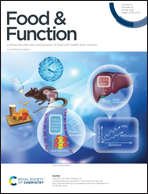Label-free proteomic analysis revealed the mechanisms of protein oxidation induced by hydroxyl radicals in whiteleg shrimp (Litopenaeus vannamei) muscle
Abstract
The oxidative effects of hydroxyl radicals derived from a FeCl3/ascorbic acid/H2O2 system on the stability of muscle proteins in peeled shrimp (Litopenaeus vannamei) were investigated. Physicochemical analysis indicated negative effects on the color (a* value), springiness, and pH of shrimp muscle, which appeared to be significantly exacerbated by higher concentrations of generated hydroxyl radicals when compared with the control. The microstructural results confirmed that a radical attack induced the incompact structure and disintegrated myofibers, thereby leading to weakened connective tissues and decreased stability of muscle proteins. Furthermore, label-free proteomic analysis revealed several differentially abundant proteins (DAPs) (i.e., ribosomal protein subunits, putative cytoskeleton proteins, and ion-binding proteins), which were detected and identified in oxidation-treated shrimp when compared with the control. The gene ontology (GO) and eukaryotic clusters of orthologous group (KOG) analyses further confirmed that the active hydroxyl radicals attacked vulnerable amino acids, modified peptide chains, and/or protein structures and/or conformations, which were responsible for a significant decrease in the muscle texture and stability of proteins in oxidation-treated shrimp. This study provides novel insight into the molecular mechanisms of muscle protein changes during oxidation development.



 Please wait while we load your content...
Please wait while we load your content...